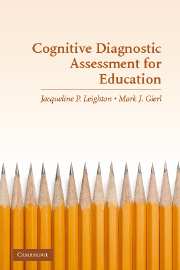Book contents
- Frontmatter
- Contents
- List of Contributors
- PART I THE BASIS OF COGNITIVE DIAGNOSTIC ASSESSMENT
- PART II PRINCIPLES OF TEST DESIGN AND ANALYSIS
- PART III PSYCHOMETRIC PROCEDURES AND APPLICATIONS
- 8 Cognitive Foundations of Structured Item Response Models
- 9 Using the Attribute Hierarchy Method to Make Diagnostic Inferences About Examinees' Cognitive Skills
- 10 The Fusion Model Skills Diagnosis System
- 11 Using Information from Multiple-Choice Distractors to Enhance Cognitive-Diagnostic Score Reporting
- 12 Directions for Future Research in Cognitive Diagnostic Assessment
- Author Index
- Subject Index
- References
9 - Using the Attribute Hierarchy Method to Make Diagnostic Inferences About Examinees' Cognitive Skills
Published online by Cambridge University Press: 23 November 2009
- Frontmatter
- Contents
- List of Contributors
- PART I THE BASIS OF COGNITIVE DIAGNOSTIC ASSESSMENT
- PART II PRINCIPLES OF TEST DESIGN AND ANALYSIS
- PART III PSYCHOMETRIC PROCEDURES AND APPLICATIONS
- 8 Cognitive Foundations of Structured Item Response Models
- 9 Using the Attribute Hierarchy Method to Make Diagnostic Inferences About Examinees' Cognitive Skills
- 10 The Fusion Model Skills Diagnosis System
- 11 Using Information from Multiple-Choice Distractors to Enhance Cognitive-Diagnostic Score Reporting
- 12 Directions for Future Research in Cognitive Diagnostic Assessment
- Author Index
- Subject Index
- References
Summary
INTRODUCTION
Many educational assessments are based on cognitive problem-solving tasks. Cognitive diagnostic assessments are designed to model examinees' cognitive performances on these tasks and yield specific information about their problem-solving strengths and weaknesses. Although most psychometric models are based on latent trait theories, a cognitive diagnostic assessment requires a cognitive information processing approach to model the psychology of test performance because the score inference is specifically targeted to examinees' cognitive skills. Latent trait theories posit that a small number of stable underlying characteristics or traits can be used to explain test performance. Individual differences on these traits account for variation in performance over a range of testing situations (Messick, 1989). Trait performance is often used to classify or rank examinees because these traits are specified at a large grain size and are deemed to be stable over time. Cognitive information processing theories require a much deeper understanding of trait performance, where the psychological features of how a trait can produce a performance become the focus of inquiry (cf. Anderson et al., 2004). With a cognitive approach, problem solving is assumed to require the processing of information using relevant sequences of operations. Examinees are expected to differ in the knowledge they possess and the processes they apply, thereby producing response variability in each test-taking situation. Because these knowledge structures and processing skills are specified at a small grain size and are expected to vary among examinees within any testing situation, cognitive theories and models can be used to understand and evaluate specific cognitive skills that affect test performance.
- Type
- Chapter
- Information
- Cognitive Diagnostic Assessment for EducationTheory and Applications, pp. 242 - 274Publisher: Cambridge University PressPrint publication year: 2007
References
- 40
- Cited by



